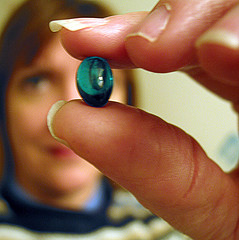
 Three out of four deaths from colon and breast cancer could be prevented. That’s approximately 58,000 new cases of breast cancer, and 49,000 new cases of colorectal cancer each year. How? By increasing vitamin D levels in the blood.
Three out of four deaths from colon and breast cancer could be prevented. That’s approximately 58,000 new cases of breast cancer, and 49,000 new cases of colorectal cancer each year. How? By increasing vitamin D levels in the blood.
That’s the conclusion reached by a group of researchers who examined epidemiological findings and over 3,000 research studies on vitamin D and cancer. According to their published paper, “It is projected that raising the minimum year-round serum 25(OH)D level to 40 to 60 ng/mL would prevent approximately 59,000 new cases of breast cancer and 49,000 new cases of colorectal cancer each year, and three fourths of deaths from these diseases in the United States and Canada….Such intakes also are expected to reduce case-fatality rates of patients who have breast, colorectal, or prostate cancer by half.”
So what does that mean? How much should we be getting? “There are no unreasonable risks from intake of 2,000 IU per day of vitamin D3,” researchers say.
Why aren’t we hearing more about this? Well, aside from the reports in the health media, marketers may be worried about confusing the public. After all, it’s taken years of messaging and lots of cash to convince people to use sunscreen and avoid the dangerous UV rays from the sun. Now, research is telling us we’re not getting enough vitamin D-as much as 85% of the public may be deficient, according to this recent paper-and one of the best ways to get it is from the sun! So what gives?
Since the benefits of vitamin D go beyond cancer prevention-it is essential for calcium absorption, can prevent or reverse osteoporosis, maintains immune function, and may prevent high blood pressure-it makes sense to explore how we can get more of it into our bodies. Of course, sun exposure is an easy, free, and efficient method, and the best way for your body to absorb the nutrient. (UVB radiation doesn’t penetrate glass, so exposure to sunshine though a window doesn’t produce vitamin D.)
But you don’t have to go overboard and increase your risk of skin cancer. According to the Mayo Clinic, as little as 10 minutes is enough to prevent deficiencies. Health.com reports that for every minute you spend in peak summer sunlight, your body can product about 1,000 IU of vitamin D. They recommend 5-10 minutes of sunshine without sunscreen on your arms, legs, or back between 10:00 a.m. and 3:00 p.m. three days a week. Women with medium-to-dark skin tones may need to up that level (by gradually increasing exposure) to 15-30 minutes. Do use sunscreen on your face and wear a wide-brimmed hat.
If you’re at risk for skin cancer, live in a cloudy climate, or find yourself suffering weeks of overcast skies in the winter, you can get your vitamin D from other sources. Fish oil and cod-liver oils both contain high levels of the nutrient, or you can try a regular pill form-just make sure it’s vitamin D3, not D2. D3 is the type your skin naturally produces when exposed to sunlight. D2 is obtained from plant sources and thought to be less effective. Certain foods also contain vitamin D, like salmon, tuna, mackerel, egg yolks, cheese, and beef liver. Check out this Vitamin D Fact Sheet provided by the Office of Dietary Supplements for more sources.
Have you experienced a vitamin D deficiency? Please share your story.
Photo courtesy tamelyn via Flickr.com.

